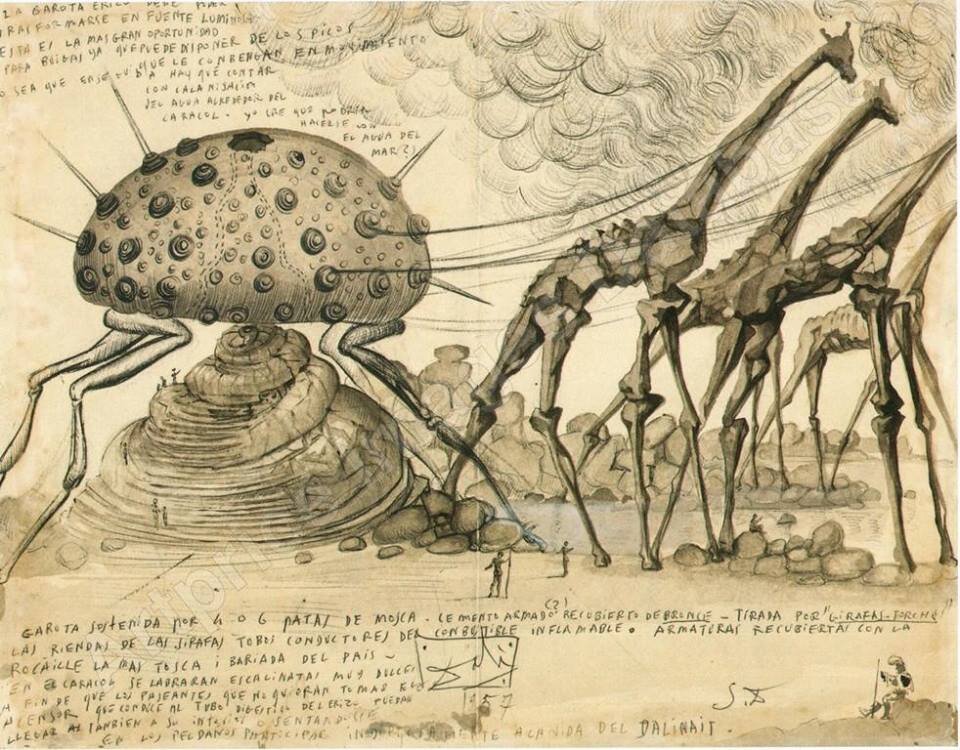Tour Dalí’s Home - Surreal!
A Sofa Inspired by Mae West
Photo via premierclocks.com
The 1931 painting, The Persistence of Memory, by Spanish artist Salvador Dalí (1904-1989), above, is the one most of us can identify as Surrealist. And we might remember his startling spider-leg mustache. But who knew that he also designed a sofa inspired by the red lips of 20s film star Mae West?
Photo via Etsy etsy.com
In the 30s Dalí was part of the French Surrealist movement established in Paris in 1924, which included writers, thinkers, as well as painters and other artists. Outlandish, quirky, and wickedly talented, Dalí struck up a friendship with Jean-Michel Frank, a well-known Parisian furniture designer and decorator.
In 1934, Dalí fixated on a newspaper photo of Mae West, finding her face to be the epitome of female beauty. In the painting, he transformed her features into parts of a room.
Later, he and Frank worked together on the design of the lips-shaped couch (below), made of wood and satin, inspired by the painting.
Photo courtesy of The Victoria & Albert Museum, London vam.ac.uk
The Subconscious Mind and the World of Dreams
Photo courtesy of Bromleys Art Supplies artsupplies.co.uk
A reportedly volatile child, Dalí was told by his parents that he was the reincarnation of his older brother, who had died 9 months before he was born. That, in addition to the loss of his beloved mother at age 16, perhaps contributed to his singular psyche.
Dalí was fascinated by Freud’s writings on the unconscious mind, the exploration of the dark mystical landscape of the subconscious, and the world of dreams, optical illusions, strange multiplications and distorted body parts. There is in addition, a geometric and mathematical rigor to his work that is often overshadowed by the arresting and provocative imagery. He once stated, “The only difference between a madman and me is that I am not mad.”
The artist experimented with self-induced hallucinations so that he could access his subconscious while making art, a process he called the paranoiac critical method. “I am the first to be surprised and often terrified by the images I see appear upon my canvas. I register without choice and with all possible exactitude the dictates of my subconscious, my dreams….,” he wrote. One technique is that he would put a tin plate on the floor and then sit in a chair beside it, holding a spoon over the plate. He would put himself into a relaxed meditative state. As he dozed off the spoon would fall from his fingers and bang onto the plate. This sudden awakening would allow Dalí to capture an image fresh from his dream life.
Dalí Noche
Photo via reforma.com
The now famously bizarre, and expensive painter from Catalan received a commission in 1957 to design a nightclub for the Hotel Presidente in Acapulco. It was to be called Dalí Noche. Dalí’s biographer Robert Descharnes and his son, Nicolas, described the undertaking:
“The proposed night club was to be named ‘Dalí Noche’: the cabaret would be a gigantic sea urchin with space for about 500 people. The seat cushions would breathe through a pneumatic system, representing the delicacy of delicacies for Dalí, the edible part of the sea urchin. The guests would arrive in its interior via an elevator incorporated into the ‘digestive tube.’ The urchin itself, supported by an ensemble of four gigantic fly legs, would be drawn toward the sea by 25 giraffes in rock, each one 15 meters high. These giraffes, each one alight, would illuminate the entire complex; the two first would be submerged for those guests who might wish to go swimming in the night.”
The plans proved to be too weird and too costly for the investors. The project was abandoned.
Furniture Design
The ever inventive Dalí also designed furniture and other decorative homeware for life as art.
Photo via somethingcurated.com via Pinterest
Photo via somethingcurated.com via YANG Gallery
The House in Catalonia, Spain
The artist’s home at the shore remains filled with his eclectic collections and his own works. He and Gala gardened, traveled, collected, created, and arranged a multitude of unusual items inside and around the stucco house; perhaps one of the world’s most eccentric residences.
Photo via worldofinteriors.com
Featuring a phallus-shaped swimming pool, it was the home of he and his wife Gala for over 40 years, and the spot for some famously outrageous parties, where pink champagne was a favorite.
Photo © Salvador Dalí courtesy of Fundació Gala-Salvador Dalí, Figueres, 2016 & Taschen Photograph via theguardian.com
Dalí loved hanging out with the famous and the rich, and displayed photos of himself and Gala with Ingrid Bergman, Lawrence Olivier, Walt Disney, and Pope John XXIII, alongside the famous Man Ray photograph of him featured on the Dec. 14, 1936, cover of Time Magazine.
Photo via thesalonhost.com
Dalí was devoted to taxidermy, thinking it a path to immortality, and several animals decorate his interiors.
Photo via thefoxisblack.com
To Dalí, the egg was symbolic of perfection and hope, and an egg sculpture sits atop the home, as well as appearing as a recurring motif in his paintings.
Photo via worldofinteriors.com
Photos courtesy of ©Salvador Dalí, Fundació Gala-Salvador Dalí, Taschen Photograph, The Victoria & Albert Museum, London, vam.ac.uk, theguardian.com, Pinterest, Etsy, etsy.com, somethingcurated.com, YANG Gallery, reforma.com, Bromleys Art Supplies, artsupplies.co.uk, worldofinteriors.com, thesalonhost.com, premierclocks.com, and thefoxisblack.com.












